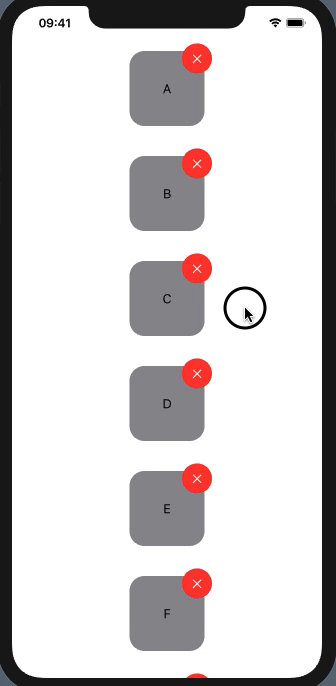Is there any way I can add animation when elements of a ForEach loop appears or disappears?
I have tried using withAnimation{} and .animation() in many ways but they didn't seem to work
Here is some code (Xcode 11 beta 5):
import SwiftUI
struct test: View {
@State var ContentArray = ["A","B","C"]
var body: some View {
ScrollView{
VStack{
ForEach(ContentArray.indices, id: \.self){index in
ZStack{
// Object
Text(self.ContentArray[index])
.frame(width:100,height:100)
.background(Color.gray)
.cornerRadius(20)
.padding()
//Delete button
Button(action: {
self.ContentArray.remove(at: index)
}){
Text("✕")
.foregroundColor(.white)
.frame(width:40,height:40)
.background(Color.red)
.cornerRadius(100)
}.offset(x:40,y:-40)
}
}
}
}
}
}
#if DEBUG
struct test_Previews: PreviewProvider {
static var previews: some View {
test()
}
}
#endif
As can be seen below, without animations everything feels super abrupt. Any solution is really appreciated
Important notice: The layout should change in the same way List does when the number of elements changes. For example, every object automatically moves top when a top object is deleted


It looks like this problem is still up to day (Xcode 11.4), because by just copy-pasting the observed effect is the same. So, there are a couple of problems here: first, it needs to setup combination of animation and transition correctly; and, second, the ForEach container have to know which exactly item is removed, so items must be identified, instead of indices, which are anonymous.
As a result we have the following effect (transition/animation can be others):

struct TestAnimationInStack: View {
@State var ContentArray = ["A","B","C", "D", "E", "F", "G", "I", "J"]
var body: some View {
ScrollView{
VStack{
ForEach(Array(ContentArray.enumerated()), id: \.element){ (i, item) in // << 1) !
ZStack{
// Object
Text(item)
.frame(width:100,height:100)
.background(Color.gray)
.cornerRadius(20)
.padding()
//Delete button
Button(action: {
withAnimation { () -> () in // << 2) !!
self.ContentArray.remove(at: i)
}
}){
Text("✕")
.foregroundColor(.white)
.frame(width:40,height:40)
.background(Color.red)
.cornerRadius(100)
}.offset(x:40,y:-40)
}.transition(AnyTransition.scale) // << 3) !!!
}
}
}
}
}
If you love us? You can donate to us via Paypal or buy me a coffee so we can maintain and grow! Thank you!
Donate Us With